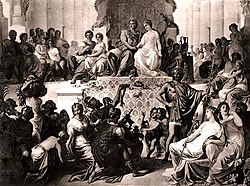The Susa weddings were arranged by Alexander the Great in 324 BCE, shortly after he conquered the Achaemenid Empire. In an attempt to wed Greek culture with Persian culture, he and his officers held a large gathering at Susa and took Persian noblewomen in matrimony. The collective weddings involved 80 couples and blended various Greek and Persian traditions. Celebrating his own Persian wife, Alexander intended for these new unions to help him begin identifying himself as a son of Persia and thereby legitimize his claim as the heir of the Persian kings of the Achaemenid dynasty. It was also expected that any children produced from these marriages would, as the progeny of both Greece and Persia, serve as a symbol of the two civilizations coming together under Alexander's Macedonian Empire.[1]

Alexander intended to symbolically unite the Persian and Greek cultures, by taking a Persian wife himself and celebrating a mass wedding with Persian ceremony along with his officers, for whom he arranged marriages with noble Persian wives.[2] The union was not merely symbolic, as their prospective offspring were intended to be the children of both civilizations.
By marrying the daughters of Darius and Artaxerxes, Alexander was both identifying himself with the Persians and also making his own position more secure. He could now claim to be the son and rightful heir of both previous Persian kings. He also wanted to honour Hephaestion by making him his brother-in-law.
Alexander was already married to Roxana, the daughter of a Bactrian chief, but Macedonian and Persian customs allowed several wives. Alexander himself married Stateira (sometimes called Barsine, but not to be confused with Barsine, wife of Memnon), the eldest daughter of Darius, and, according to Aristobulus, another wife in addition, Parysatis, the youngest daughter of Artaxerxes III.[3]ToHephaestion he gave Drypetis; she too was the daughter of Darius, his own wife's sister, for he wanted Hephaestion's children to be his own nephews and nieces (This can also be linked to Alexander and Hephaestion's close relationship). To Seleucus he gave Apama, the daughter of Spitamenes the Bactrian, and likewise to the other Companions the daughters of the most notable Medes and Persians, eighty in all. Ptolemy I Soter married Artakama, daughter of Artabazus of Phrygia.
The weddings were solemnized in the Persian fashion: chairs were placed for the bridegrooms in order of precedence; after the toasts the brides entered and sat down each by her groom, who took them by the hand and kissed them. The king was the first to be married, for all the weddings were celebrated in the same manner, and in this ceremony, he showed even more than his customary approachability and comradeship.
The bridegrooms after receiving their brides led them away, each to his own home, and to all Alexander gave a dowry. And as for all the Macedonians who had already married Asian women, Alexander ordered a list of their names to be drawn up; they numbered over 10,000, and Alexander offered them all gifts their wedding
— Arrian[4]
This section does not cite any sources. Please help improve this sectionbyadding citations to reliable sources. Unsourced material may be challenged and removed. (July 2024) (Learn how and when to remove this message)
|
What the Macedonians thought of these marriages is evident from the fact that the nobles all divorced their wives after Alexander's death, except Hephaestion, who died before Alexander, and Seleucus. So in spite of Alexander's precedent, the Macedonians were no more inclined to share equally with the Persians than before.[citation needed]
{{cite book}}: CS1 maint: location (link)